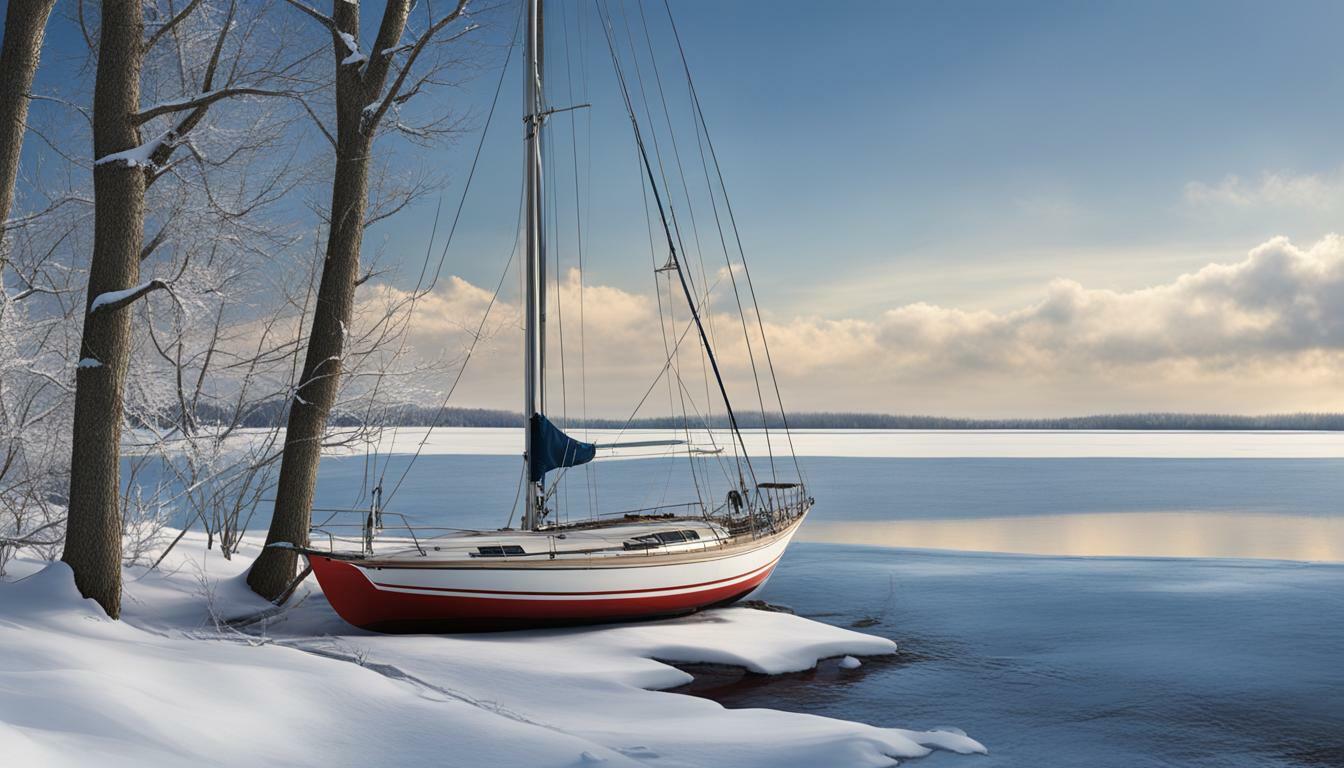Winterizing a boat is an essential step to ensure that it is properly prepared for the cold winter months and prevent any damage that may occur due to freezing temperatures. It is important to follow a checklist and perform the necessary tasks to winterize a boat successfully.
Key Takeaways:
- Winterizing a boat is important to prevent costly repairs and protect it from freezing temperatures.
- A certified technician should be hired to ensure the boat is properly cared for during winterization.
- The winterization checklist includes draining the engine, winterizing the heater and shower systems, treating the fuel system, and removing drain plugs.
- Specific steps should be followed according to the owner’s manual, depending on the type of engine.
- The boat should be properly covered or shrink wrapped to keep out moisture and vermin.
Taking Care of the Engine
One crucial aspect of winterizing a boat is taking care of the engine. The engine pulls water from the lake to keep it cool while running, so draining all the water out of the engine is essential to prevent any cracking or damage to the engine block and components when temperatures drop below freezing.
Professional grade environmentally safe antifreeze should be used throughout the engine block and cooling system to provide protection against rust and corrosion. This will help ensure that your engine is ready to go when the warmer weather arrives.
In addition to the engine, the heater core, shower system, ballast tanks, and fuel system should also be winterized. This includes using fuel stabilizer to maintain the integrity of the fuel over the winter months.
It is recommended to winterize the boat even if it is stored in a heated garage. This provides cheap insurance against power outages or accidental exposure to freezing temperatures.
Properly winterizing the engine and other systems can help prevent costly repairs and ensure that the boat is ready for use in the spring. So, take the time to winterize your boat properly and ensure that you can enjoy it to the fullest come boating season.
Winterizing the Heater System
If the boat is equipped with a heater system, it also needs to be winterized. The core of the heater can crack and leak water if not properly winterized, so draining the heater cores, blowing air through the system, and running antifreeze can protect it against corrosion.
Additionally, other systems that pull water in from the lake, such as the shower pump and ballast tanks, should also be drained and protected with antifreeze. Treating the fuel system with fuel stabilizer is another vital step to preserve the integrity of the fuel during the winter months.
When winterizing your boat, it is important to consider the specific requirements of your engine type. Outboard engines should be tilted down to drain all water from the cooling system, while stern drives may require antifreeze to be run through both the engine and drive unit. Inboards can be drained by opening petcocks or running antifreeze through the system.
Fuel systems should be treated with fuel stabilizer and fuel filters should be replaced. Plumbing systems, including sinks, tanks, and heads, should be drained and antifreeze should be run through them to prevent freezing. It is also important to remove drain plugs and store valuables off the boat to prevent damage.
In summary, winterizing the heater system is a crucial step in preparing your boat for the winter season. Properly draining and protecting the heater core, as well as other systems that pull water in from the lake, will help prevent damage and ensure your boat is ready for use in the spring. Following the specific guidelines for your engine type and treating fuel and plumbing systems are also essential in winterizing your boat effectively.
Winterizing the Shower System
The shower system is another critical aspect to consider when winterizing a boat. The shower pump, shower head, and hoses can crack due to freezing temperatures, so draining the shower system, blowing it dry, and running antifreeze through the pump, shower head, and hoses is necessary.
To drain the system, first turn off the water supply and open the shower drain to allow the water to flow out. Then, remove the shower head and allow the water to drain from the hose. Once drained, use an air compressor to blow out any remaining water from the shower head and hose.
Next, it is recommended to run antifreeze through the shower system using a winterizing kit. This kit includes a hose that attaches to the pump’s intake and a container of antifreeze. Simply submerge the hose in the container and turn on the pump until the antifreeze runs through the shower head and hose.
Winterizing the shower system may seem like a small task, but it is an important step in preventing costly damage and ensuring the system is ready to use in the spring. Remember to also winterize other systems on the boat, such as the engine, heater core, ballast tanks, fuel system, and plumbing systems, to protect your boat and investment for years to come.
Winterizing Ballast Tanks and Systems
Ballast tanks and systems should be drained, and some boat manufacturers require antifreeze in the tanks for proper winterization. This is to prevent any remaining water from freezing and causing damage to the system. If your boat has a ballast system, ensure that you know the manufacturer’s recommendations for winterization, as the process may vary depending on the type of system.
The first step in winterizing the ballast system is to drain any water from the tanks. This can be done by using the boat’s bilge pump or by manually removing the drain plugs. Once the water is drained, it is important to run antifreeze through the system to ensure that any remaining water is displaced. Some boats have a separate antifreeze inlet, while others require the antifreeze to be introduced through the raw water intake. Again, refer to the manufacturer’s recommendations for your specific boat.
After the antifreeze has been introduced, it is important to cycle it through the system to ensure that all components are properly winterized. This can be done by running the boat’s pump until the antifreeze is visible coming out of all the ballast tank outlets. It is also important to ensure that any ballast bags or sacs are properly drained and stored for the winter.
By properly winterizing your boat’s ballast tanks and systems, you can avoid any potential damage and costly repairs in the spring. Be sure to refer to your boat’s owner manual or consult with a certified technician to ensure that you are performing the correct steps for your specific boat.
Treating the Fuel System
To ensure the integrity of the fuel over the winter months, treating the boat’s fuel system with fuel stabilizer is crucial. This step helps keep the fuel lasting and prevents any damage that may occur due to prolonged inactivity.
Fuel stabilizer should be added to the fuel system before the boat is stored away for the winter. This will help to prevent issues such as phase separation when using ethanol blended fuel.
It is important to run the engine after adding the stabilizer to ensure that it is circulated throughout the entire system. This will help preserve the fuel and prevent any damage or issues that may occur during the winter months.
In addition to treating the fuel with stabilizer, it is also necessary to change the engine’s fuel filters and any fuel/water separators. This will ensure that any contaminants or impurities are removed from the fuel system, further preserving the engine and the fuel.
Proper winterization of the fuel system can prevent costly repairs and ensure the boat is ready to be enjoyed in the spring. By following these steps and taking care of the fuel system, boat owners can rest easy knowing that their vessel will be in top condition when the warmer weather returns.
Winterizing for all Circumstances
Even if a boat is kept in a heated garage, it is still recommended to winterize it. This is a cheap insurance policy for power and gas outages or any unforeseen circumstances. Winterizing the boat prevents the risk of a cracked block in case the garage door or any door is left open.
While a heated garage may seem like a safe place to store a boat during the winter season, it is important to remember that accidents can happen. Without proper winterization, a boat left in a heated garage can still experience damage from freezing temperatures. It is important to go through the winterization process to ensure your boat is adequately protected.
Additionally, it is important to understand that winterization is not just about protecting the boat from cold weather; it is also about protecting the boat from sitting unused for a long period of time. Proper winterization will help prevent issues such as fuel contamination and battery problems that can arise from long periods of inactivity.
By taking the time to properly winterize your boat, you can ensure that it will be protected throughout the winter season and be ready to hit the water when spring comes around.
General Winterization Steps
In addition to these specific tasks, there are some general steps that apply to all boats when it comes to winterization. Cleaning the boat thoroughly, including washing down the outer hull, props, rudder, and shaft, is important to remove any saltwater or dirt. This is especially crucial for saltwater vessels. Once the boat is clean, remove all valuables and personal items, as well as any non-essential equipment. This will make the winterization process easier and reduce the risk of damage to valuable items.
The next step is to cover the boat with a boat cover or shrink wrap. This will help to prevent moisture from entering the boat and causing damage to the interior or systems. It will also help to keep out vermin, who may be looking for a warm place to spend the winter months.
Once the boat is covered, it is important to remove drain plugs from the hull and other systems to allow any water to drain out. This includes the engine, ballast tanks, and any other systems that may have collected water. Be sure to check the owner’s manual for the specific locations of drain plugs and how to remove them.
The bilge should also be cleaned and any water or debris removed. Any remaining water can cause damage to the boat’s interior or systems, so be sure to check all areas of the bilge and remove any water that may be present.
Finally, it is important to choose the right antifreeze for the boat’s freshwater systems. Non-toxic antifreeze should be used, and it is important to choose antifreeze that is effective in the expected cold temperatures. Follow the manufacturer’s instructions carefully to ensure that the antifreeze is properly added to the system.
By following these general winterization steps, boat owners can protect their vessels and prevent costly repairs. It is important to check the owner’s manual for any specific steps required for the boat’s type of engine and systems. With proper winterization, a boat can be ready to go when the spring season arrives.
Conclusion
In conclusion, winterizing a boat is a critical step to prevent any damage that may occur due to freezing temperatures. Properly preparing the engine, fuel system, plumbing systems, and other parts of the boat can prevent costly repairs and ensure that the boat is ready for use when the winter season is over. Following a detailed checklist, consulting the owner’s manual, and using the right products are key to successfully winterize a boat.
It is crucial to drain any water from the engine, plumbing, and other systems that hold water. Adding antifreeze and running fuel stabilizer is also a necessary step in the process. It is important to note that consulting the owner’s manual is essential to get specific instructions based on the type of engine and boat you have.
Remember to remove any valuable items from the boat and cover it properly to keep out moisture and vermin. Furthermore, it is critical to pay attention to the type of antifreeze and its freezing point.
By following these steps, you can safely store your boat during the winter months and be ready to hit the water again in the spring. Winterizing your boat not only prevents costly repairs, but it also ensures that you can enjoy your boat when spring arrives. Therefore, it is essential to make sure your boat is winterized before the cold weather sets in.
FAQ
Q: Why is winterizing a boat important?
A: Winterizing a boat is essential to prevent any damage that may occur due to freezing temperatures and ensure the boat is properly prepared for the winter months.
Q: What are the key steps to winterize a boat?
A: The key steps to winterize a boat include taking care of the engine, winterizing the heater system, shower system, and ballast tanks, treating the fuel system, preparing for all circumstances, following general winterization steps, and covering the boat for protection.
Q: How do I winterize the boat’s engine?
A: To winterize the boat’s engine, it is important to drain all the water out of the engine, run antifreeze through the system, and follow the specific steps for inboard engines, outboard motors, or sterndrive engines as outlined in the owner’s manual.
Q: What should I do to winterize the boat’s heater system?
A: To winterize the boat’s heater system, it is necessary to drain the heater cores, blow air through the system, and run antifreeze to protect it against corrosion.
Q: How do I winterize the boat’s shower system?
A: To winterize the boat’s shower system, it is important to drain the system, blow it dry, and run antifreeze through the pump, shower head, and hoses to prevent any cracking or damage due to freezing temperatures.
Q: What steps are involved in winterizing ballast tanks and systems?
A: Winterizing ballast tanks and systems typically involve draining the tanks and adding antifreeze to protect against freezing and damage.
Q: How do I treat the boat’s fuel system during winterization?
A: Treating the boat’s fuel system with fuel stabilizer is crucial to keep the fuel lasting and prevent any damage that may occur due to prolonged inactivity.
Q: Is it necessary to winterize a boat stored in a heated garage?
A: Yes, it is still recommended to winterize a boat stored in a heated garage as a cheap insurance policy for power and gas outages or any unforeseen circumstances that may leave the boat exposed to freezing temperatures.
Q: What are the general steps for winterizing a boat?
A: General steps for winterizing a boat include cleaning the boat thoroughly, treating the fuel system, cleaning the bilge, removing water from additional systems, removing valuable items, and covering the boat with a properly fitted cover or shrink-wrapping it.
Source Links
- https://www.taylorsboats.com/blog/your-winterization-checklist–28952
- https://www.discoverboating.com/ownership/storage/winterizing
- https://www.boatsafe.com/winterizing-boat/
- https://www.kars4kids.org/boat/winterizing-guide.php
- https://www.boats.com/how-to/how-to-winterize-a-boat/
- https://www.boatus.com/expert-advice/expert-advice-archive/2012/july/winterizing-your-boat-engine
- https://www.boatus.com/expert-advice/expert-advice-archive/2013/july/how-to-winterize-boat-engines-and-drives
- http://www.clubsearay.com/index.php?threads/winterize-hot-water-heater.24077/
- https://www.westmarine.com/west-advisor/Winterizing-Potable-Water-Systems.html
- https://marinehowto.com/freshwater-system-winterizing/
- https://jetboaters.net/threads/winterization-of-the-shower.7787/
- https://www.myboatlife.com/2020/11/boat-winterization-how-to-winterize-fresh-water-raw-water-systems-on-your-boat.html
- https://fishtalkmag.com/blog/winterizing-your-boat-5-easy-steps
- https://forum.moomba.com/showthread.php?35755-Winterizing-Ballast-System-Without-Removing-The-Bags
- https://www.boatingmag.com/how-to-winterize-ballast-tanks/
- https://www.themalibucrew.com/index.php?/forums/topic/51974-winterizing-ballast-tanks/
- https://www.boats.com/how-to/winterizing-your-boats-fuel-tank/
- https://seafoamworks.com/shop-talk/how-to-stabilize-your-boat-fuel-for-the-winter/
- https://www.boatingmag.com/how-to/winterizing-gasoline-fuel-systems/
- https://www.goldeagle.com/tips-tools/how-winterize-your-boat/
- https://www.wikihow.com/Winterize-a-Boat
- https://maritimepage.com/how-to-winterize-a-boat/
- https://premierwatersports.net/how-to-prepare-your-boat-for-winter-a-step-by-step-guide/
- https://valleymarine.net/2022/08/26/winterizing-your-boat/



